<MOSCOW, (Rus.
Moskva), capital of the U.S.S.R. and from the Middle Ages
the political, economic, and commercial center of *Russia.
[Some Jews in Moscow up to
the 18th century - general prohibition to settle in
Moscow]
Up to the end of the 18th century, Jews were forbidden to
reside in Moscow although (col. 359)
[[The criminal orthodox "Christians" Church was the driving
force against the Jews but is never mentioned in the
article]].
many Jewish merchants from Poland and Lithuania visited the
city. In 1676 Jews who brought their wares to Moscow were
expelled. Apostates and forced converts who maintained
varying degrees of connection with Judaism and the Jews were
to be found in Moscow during various periods. A few Jews
among the prisoners brought to Moscow after the wars against
Poland apostatized and settle there. A physician of Jewish
origin, Daniel Gordon, was employed by the court in Moscow
from 1657 to 1687; Peter Shafirov, one of the most important
advisers of Czar Peter the Great, was also of Jewish origin.
[Belarus Jews from Shklov
in Moscow since 1772 - only temporary stay permitted since
1791]
With the Russian annexation of Belorussia (1772), the number
of Jewish merchants living in Moscow for commercial reasons
increased; they came in particular from *Shklov, then an
important commercial center in Belorussia. One of these was
the contractor and merchant Nathan Note *Notkin.
In 1790 Moscow merchants requested that the presence and
commercial activities of the Jews in the city be prohibited.
A royal decree forbidding Jewish merchants to settle in the
inner districts of Russia was issued in 1791. However, they
were authorized to stay for temporary periods in Moscow to
carry on their trade. Most of the Jews who came to Moscow
lodged at the Glebovskoye podvorye, an inn which was
situated in the center of the market quarter.
[Jewish merchants between
Moscow and the West and the South - Jewish export trade]
Jewish merchants continued to play an important role in the
trade between Moscow and the southern and western regions of
Russia, as well as in the export of Moscow's goods, and in
1828 the turnover of this trade was estimated at 27,000,000
rubles. As a result, Russian industrialists in Moscow
supported the rights of (col. 360)
the Jews.
[Guild Jews with the right
to remain one month in Moscow since 1828 - Glebovskoye inn
- prolonged stay of six months]
In 1828 Jewish merchants who were members of the first and
second guilds were authorized to remain in Moscow on
business for a period of one month only. They were forbidden
to open shops or to engage in trade within the city
boundaries. To facilitate the execution of these
regulations, the Jews were compelled to lodge solely in the
Glebovskoye podvorye. The inn was a charitable trust which
had been handed over to the Moscow city council to use its
income for the maintenance of a municipal eye clinic.
Exorbitant prices were soon extorted from Jewish merchants
who had to stay at the inn.
After a few years, third-class merchants were also
authorized to enter the town under the same conditions and
the period of their stay was prolonged to six months. About
250 people made use of this right every year. As a result of
these restrictions Jewish trade decreased to about
12,000,000 rubles annually during subsequent years.
[Temporary residence in
whole Moscow for Jews since 1855]
When Alexander II came to the throne (1855), Jewish
merchants were permitted to reside temporarily in all the
sections of the town.
[Permanent settlement of
Jewish Cantonists - professions and careers]
The first Jews to settle permanently in Moscow, and the
founders of the community, were *Cantonists who had finished
military service, some of whom had married Jewish women from
the *Pale of Settlement. In 1858 there were 340 Jewish men
and 104 Jewish women in the whole of the district of Moscow.
After Jewish merchants of the first guild, university
graduates, and craftsmen were allowed to settle in the
interior of Russia, the number of Jews increased rapidly.
Some were extremely wealthy, such as Eliezer *Polyakov, one
of the most important bankers in Russia and head of the
community, and K.Z. *Wissotzki.
From 1865 to 1884 Hayyim (Ḥayyim) Berlin officiated as rabbi
of Moscow, and in 1869 the community invited S.Z. *Minor,
one of the outstanding students of the Vilna rabbinical
seminary, to serve as the
*kazyonny
ravvin (government-appointed rabbi).
[Numbers 1871-1890 -
liberal governor of Moscow, Prince Dolgorukov]
There was an estimated Jewish population of 8,000 in the
city in 1871, which had grown to around 12,000 in 1882 and
35,000 (over 3% of the total population) in 1890, just
before the expulsion.
The governor of Moscow, Prince Dolgorukov, was known for his
liberal attitude toward the Jews, and (after receiving
bribes and gifts) the local administration overlooked their
illegal presence (as in the case of fictive craftsmen). A
considerable number of industrialists and merchants
recognized the advantages deriving from Jewish presence in
the city, and in a memorandum addressed to the minister of
finance in 1882 they pointed out their great contribution to
the city's prosperity.
While anti-Jewish persecutions and decrees were gaining
momentum throughout Russia after the accession of Alexander
III, a period of relative ease, the legacy of the previous
czar, continued in Moscow. This situation (col. 363)
changed completely with the deposition of Prince Dolgorukov
and the appointment of Grand Prince Sergei Alexandrovich as
governor of the city. During the 14 years (1891-1905) of his
term in office, his main aim was "to protect Moscow from
Jewry".
The Expulsion.
[The expulsion decree of
the Jews of Moscow in 1891 under Grand Prince Sergei
Alexandrovich - expulsion of about 30,000 Jews in 1892 -
flight to Warsaw and Lodz]
On March 28, 1891 (Passover Eve 5651), a law was issued
abolishing the right of Jewish craftsmen to reside in Moscow
and prohibiting their entry into the city in the future. The
police immediately began to expel thousands of families,
some of whom had lived in Moscow for several decades or were
even born there. They were granted a period of from three
months to a year to dispose of their property and many were
compelled to sell out to their neighbors at derisory prices.
The poor and destitute were sent to the Pale of Settlement
with criminal transports. On October 15 the right of
descendants of the Cantonists to live in the town was
abrogated, if they were not registered with the Moscow
community. The expulsion reached its climax during the cold
winter days of 1892. While the police made a concerted
effort to search out the Jews and drive them out of the
city, generous rewards were offered for the seizure of any
still in hiding.
The press was not permitted to report on the details of the
expulsion. An appeal to the government made by merchants and
industrialists in 1892 and their warning of the economic
damage that would result from the expulsion were of no
avail. Police sources estimated that about 30,000 persons
were expelled. About 5,000 Jews remained - families of some
Cantonists, wealthy merchants and their servants, and
members of the liberal professions.
[[As it seems the brutal police force is collaborating
willingly and makes career with the expulsion of the Jews.
And the criminal Orthodox "Christian" Church is never
mentioned in the article]].
The Moscow expulsion came as a deep shock to Russian Jewry.
A considerable number of those expelled arrived in Warsaw
and Lodz and transferred their economic activities there.
[[...]]
In 1893 J. *Mazeh was elected as rabbi of Moscow, remaining
its spiritual leader until his death in 1923. [[...]] In
1897 there were 8,095 Jews and 216 Karaites in Moscow (0.8%
of the total population). [[...]]
[More restrictions for the
staying bout 5,000 Jews]
Decrees regulating residence in Moscow became even more
severe. In 1899 the authorities ordered that no more Jewish
merchants were to be registered in the first guild unless
authorized by the minister of finance. At the height of the
expulsion period, the authorities closed down the new
synagogue, as well as nine of the 14 prayer houses. Rabbi
S.Z. Minor, who requested the reopening of the synagogue,
was expelled from the city. The struggle for the use of the
synagogue continued for many years and it was not until 1906
that permission was granted for its reopening. [[...]]
In 1902 there were 9,339 Jews there, and half of them
declared Yiddish as their mother tongue; the overwhelming
majority of the others declared it to be Russian. [[...]]
A considerable
number of the members of the small community were wealthy
merchants and intellectuals. Assimilated Jews (some of whom
apostatized) held an important place in the cultural life of
the city. In 1911 there were around 700 Jewish students in
the higher institutions of learning in Moscow.
![Encyclopaedia Judaica (1971):
Moscow, vol. 12, col. 359-360. Twenty-fifth
anniversary meeting in Moscow of the early [[racist]]
Zionist group, Benei Zion, 1909. The photograph
includes: 1. Jehiel Joseph Levontin, 2. Jacob Mazeh,
3. Jehiel Tschlenow, 4. Pesah Marek, 5. Isaac
Naiditsch, 6. Eliezer Tcherikower. Jerusalem,
J.N.U.L., Schwadron Collection Encyclopaedia Judaica (1971): Moscow, vol. 12,
col. 359-360. Twenty-fifth anniversary meeting in
Moscow of the early [[racist]] Zionist group, Benei
Zion, 1909. The photograph includes: 1. Jehiel Joseph
Levontin, 2. Jacob Mazeh, 3. Jehiel Tschlenow, 4.
Pesah Marek, 5. Isaac Naiditsch, 6. Eliezer
Tcherikower. Jerusalem, J.N.U.L., Schwadron
Collection](EncJud_Moskau-d/EncJud_Moscow-band12-kolonne359-360-rass-zionisten1909-33pr.jpg)
Encyclopaedia
Judaica
(1971): Moscow, vol. 12, col. 359-360. Twenty-fifth
anniversary meeting in Moscow of the early [[racist]]
Zionist group, Benei Zion, 1909. The photograph
includes: 1. Jehiel Joseph Levontin, 2. Jacob Mazeh, 3.
Jehiel Tschlenow, 4. Pesah Marek, 5. Isaac Naiditsch, 6.
Eliezer Tcherikower. Jerusalem, J.N.U.L., Schwadron
Collection
After the outbreak of World War I, from 1915, a stream of
Jewish refugees began to arrive in Moscow from the
German-occupied regions. They took part in the development
of war industries in the town and some of them amassed large
fortunes. In a short time, Moscow became a Jewish center.
[[The Jewish refugees were expelled by the Russian army from
the frontier districts, see *
Lithuania,
*
Latvia,
and *
Estonia]].
Hebrew printing presses were set up, and in the town of
Bogorodsk (near Moscow) a large yeshivah [[religious Torah
school]] was established on the pattern of the Lithuanian
yeshivot [[religious Torah schools]]. Thee foundations of
the Hebrew theater *Habimah were then laid. Among the new
rich were [[racist]] Zionists and nationally conscious Jews
who were ready to support every cultural activity. Most
outstanding of these were H. *Zlatopolsky, his son-in-law Y.
Persitz, and A.J. *Stybel. Authorization was given for the
publication of a Hebrew weekly,
Ha-Am.
[February revolution of
1917]
Cultural activity increased in scope with the outbreak of
the (col. 364)
February 1917 Revolution. It was symbolical that O. *Minor,
the son of S.Z. Minor, a leader of the Social Revolutionary
Party, was elected as chairman of the Moscow municipal
council. [[...]]
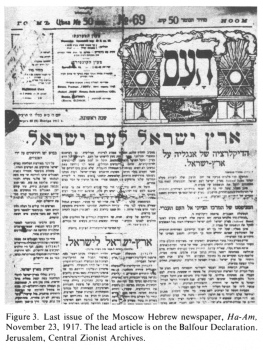
Encyclopaedia Judaica (1971): Moscow, vol. 12, col. 362.
Last issue of the Moscow Hebrew newspaper, Ha-Am, November
23, 1917. The lead articleis on the Balfour Declaration.
Jerusalem, Central Zionist Archives.
When Moscow became the capital of the Soviet Union, its
Jewish population rapidly increased. In 1920 there were
28,000 Jews in the city, which had become severely
depopulated as a result of the civil war. By 1923 the number
had increased to 86,000 and by 1926 to 131,000 (6.5% of the
total population). [[...]]
[More Jewish cultural
activities in Moscow - 400,000 Jews estimated in 1940]
Ha-Am became a daily newspaper and two large
publishing houses, Ommanut (founded by Zlatopolsky and
Persitz) and that of A.J. Stybel, were set up. The founding
conference of the organization for Hebrew education and
culture, *Tarbut, was held in Moscow in the spring of 1917.
This activity also continued during the first year of the
Bolshevik Revolution (three volumes of
Ha-Tekufah were
published in 1918, as well as others) but the new regime,
with the assistance of its Jewish supporters, rapidly
liquidated the institutions of Hebrew culture in Moscow.
The Habimah theater was more fortunate; it presented
An-Ski's
Dibbuk (Dybbuk)
in Moscow for the first time in January 1922 and continued
to exist under the protection of several prominent members
of the Russian artistic and literary world who defended it
as a first class artistic institution, until it left the
Soviet Union in 1926. [[...]]
[[The Communist terror against the merchants and the NEP
policy are not mentioned in this article, see: *
Soviet
Union. The Gulag system and forced labor system in
"Soviet Union" with the construction of long railroad lines
or canals accompanied by mass death by freezing or hunger
etc. are never mentioned in Encyclopaedia Judaica]].

Encyclopaedia Judaica (1971): Moscow, vol. 12, col.
361-362. The Moscow Jewish State Theater in a
production of "King Lear" with S. Mikhoels in the title
role, 1935. Courtesy C.A.H.J.P., Jerusalem.
In 1940 the Jewish population was estimated at 400,000. the
headquarters of the *Yevsektsiya was situated in Moscow, and
there its central newspaper
Der Emes (1920-38) was published as well
as many other Yiddish newspapers and books. The Jewish State
Theater (known in Russian as GOSET from its initials),
directed by S. *Mikhoels, was also situated in Moscow. For a
number of years, small circles of organized [[racist]]
Zionists continued to exist in the city, which was the
central seat of the legal *He-Halutz (He-Ḥalutz) (which
published its own newspaper from 1924 to 1926) and of the
groups of the Left *Po'alei Zion. All these were liquidated
by 1928.
[World War II -
Anti-Fascist Committee and newspaper "Eynikeyt"]
During World War II, the Jews shared the sufferings of the
war with the city's other inhabitants. From 1943 Moscow was
seat of the Jewish *Anti-Fascist Committee which gathered
together personalities of Jewish origin who were outstanding
in Soviet public affairs. Founded to assist the Soviet Union
in its war effort against Nazi Germany and to mobilize world
Jewish opinion and aid for this purpose, it published a
newspaper, Eynikeyt [[Yidd.: "Unity"]].
[Y.S.]
[[The Big Flight from Barbarossa, the circumstances in the
hard winters and the defense battles before Moscow are not
mentioned]].
After World War II.
[Destruction of the Jewish communities since 1948]
The Anti-Fascist Committee attempted to continue with its
activities even after the war until it was brutally
liquidated in 1948-49, as a first step in the total
liquidation of organized Jewish life in the "black years" of
Stalin's regime.
[[Since 1948 - since the foundation of a racist Zionist Free
Mason CIA Herzl Israel - Stalin's anger was headed against
the Jews in general, because the new "Jewish State of
Israel" - with the aim of borderlines at the Nile and at the
Euphrates (according to 1st Mose, chapter 15, phrase 18) -
was collaborating with the criminal "USA" and it's secret
service CIA. By this Stalin and his government felt
encircled by the Western powers, and corresponding measures
were taken to destroy any Western structure in the Soviet
Union, so, also all Jewish life. And the "Soviet Union" was
supporting all Arab states against racist Zionist
imperialism. By all this there was born the eternal war in
the Middle East. Stalin's regime wanted to have Israel as a
Communist satellite on the Mediterranean Sea...]]
Most of its [[the Anti-Fascist Committee's]] leading members
were arrested and executed in 1952.
[Representatives from
racist Zionist Free Mason CIA Herzl Israel in Moscow -
demonstrations]
Because Moscow is the capital and a "window" of the Soviet
Union, it has been (col. 365)
possible for world Jewry to follow the destinies of Moscow's
Jews more than those in other cities and the latter have
been more able to meet with Jews from outside the Soviet
Union. When Golda *Meir, the first diplomatic representative
of the [[racist Zionist Free Mason CIA Herzl]] State of
Israel, arrived in Moscow in September 1948, a spontaneous
mass demonstration of Jews in her honor took place on the
High Holidays near and around the Great Synagogue. The mere
presence of an Israel diplomatic mission with an Israel flag
in the center of Moscow was a constant stimulus to Jewish
and pro-Israel sentiments among the Jews of Moscow and
Jewish visitors from other parts of the Soviet Union.
The Israel delegation to the Youth Festival, held in Moscow
in 1957, was the first occasion of personal contacts between
Jewish youth from [[racist Zionist Free Mason CIA Herzl]]
Israel and the U.S.S.R. It is considered to have been a
turning point in the revival of Jewish national feelings and
their daring demonstration in public on the part of Soviet
Jewish youth.
Already in 1958, on *Simhat (Simḥat) Torah eve more than
10,000 young Jews gathered around the Great Synagogue to
dance and sing Yiddish and Hebrew songs. They refused to be
intimidated by the militia and to disperse. Thus these mass
gatherings of young Jews, which also take place on their
Jewish holidays, became a traditional feature of Jewish life
in Moscow.
In 1955 some elderly Jews were tried and sentenced to
several years of imprisonment in labor camps for possessing
and distributing Israel newspapers and Hebrew literature and
gathering in groups to read them. For similar "offenses"
several Jews of the Great Synagogue congregation were
punished in 1963. (col. 366) [[...]]
From 1961 a barrier was erected in the Great Synagogue to
separate foreign visitors, including Israel diplomats, from
the congregation, and the synagogue officers were
responsible to the authorities for strictly enforcing the
segregation. (col. 367) [[...]]
[Numbers]
In the census of 1959, 239,246 Jews (4.7% of the total
population) were registered in the municipal area of Moscow.
Of these, 132,223 were women and 107,023 were men. 20,331 of
them (about 8.5%) declared Yiddish to be their mother
tongue. These numbers are thought to be a gross
underestimate because many tens of thousands of Jews
declared at the census their "nationality" to be Russian
(some opinions evaluate the number of Moscow's Jews as high
as 500,000). (col. 368)
[Pogrom of 1959: fire in
the synagogue - murder of the shammash - graffiti]
In 1959, on Rosh Ha-Shanah eve, an anti-Jewish riot took
place in Malakhovka, a suburb of Moscow. The synagogue was
set afire, but quickly extinguished; the
shammash [[salaried
servant in a synagogue]] of the Jewish cemetery was murdered
by unknown persons and on the walls a typewritten
anti-Semitic tract appeared, signed by "the B.Zh.S.R.
Committee", the Russian initials of the prerevolutionary
anti-Semitic slogan "Hit the Yids and save Russia".
At first Soviet spokesmen denied the facts, but several
months later admitted them to foreign visitors, assuring
them that the hooligans were apprehended and severely
punished. The Soviet press did not mention the incident at
all.
[[It can be admitted that there were many more pogroms]].
[Jewish cemetery
discontinued since 1960 - economic trials]
In 1960 a stir was created among Moscow Jewry when burying
at the Jewish cemetery was almost discontinued and Jews were
forced to bury their dead in a separate section of a general
cemetery. This section was filled up in 1963 and subsequent
Jewish burials had to take (col. 367)
place alongside non-Jewish ones. Some Jews in various ways
obtained the privilege of burying their dead in the
remaining space of the old Jewish cemetery, others carried
them to the Jewish cemetery of Malakhovka.
At the same period several Jews in Moscow were accused,
tried, and sentenced to the severest punishment, including
execution, for "economic crimes", such as speculation,
organizing illicit production and sale of consumer goods in
collusion with high officials of the militia, directors of
factories, etc. Their trials were accompanied by
inflammatory feature articles (called "feuilletons") in the
central Moscow press with pronounced anti-Semitic overtones.
[[After every war in the Middle East with a winner named
"Israel" (racist Zionist Free Mason CIA Herzl Israel) there
was a new anti-Semitic propaganda wave, with the destruction
of cemeteries step by step, of synagogues, and with new
discrimination laws]].
[Yiddish culture in Moscow:
Yiddish newspapers and writers]
However, Moscow was also the center of other developments.
IN 1959 some Yiddish books, most of them selective works of
the classics (*Shalom Aleichem, I.L. *Peretz, D. *Bergelson,
etc.), were published there after a prolonged period of the
complete obliteration of any printed Yiddish word. Yiddish
folklore concerts took place relatively frequently in the
city and drew large crowds. Even a semiprofessional theater
troupe, headed by the elderly actor Benjamin Schwartzer, was
established and mainly performed Shalom Aleichem plays in
provincial cities. In 1961 the Yiddish journal
*Sovetish Heymland
[[Soviet Homeland]] edited by an officially appointed
editor, the poet Aaron *Vergelis, began to appear as an
"organ of the Soviet Writers' Union", first as a bimonthly,
later as a monthly. It also served as a kind of
Soviet-Jewish mouthpiece for foreign Jews and visiting
Jewish intellectuals were invited to its premises to meet
members of its editorial staff. In 1963 and 1965 collections
of Israel Hebrew poetry and prose were published in Russian
translation, as well as a Hebrew-Russian dictionary in 1965
(in 25,000 copies), which was sold out in a few weeks.
[Cultural life - Rabbi
Schliefer, a pacifist rabbi with revised Jewish prayer
book without wars]
The Great Synagogue and its rabbi (first S. *Schliefer and
after his death J. L. *Levin) serve the authorities often as
unofficial representatives of Soviet Jewry to the outside
world.
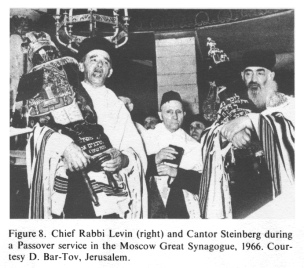
Encyclopaedia Judaica (1971): Moscow, vol. 12, col. 367.
Chief Rabbi Levin (right) and Cantor Steinberg during a
Passover service in the Moscow Great Synagogue, 1966.
Courtesy D. Bar-Tov, Jerusalem.
In the 1950s and 1960s the Great Synagogue was allowed to
issue a Jewish calendar and to sent it to other synagogues
in the U.S.S.R. In 1956 Rabbi Schliefer was granted
permission to print a prayer book, by photostat from old
prayer books. He named it
Siddur
ha-Shalom ("peace prayer book") and deleted from it
all references to wars and victories (as, e.g., in the
Hanukkah (Ḥanukkah) benedictions). It was said to have been
printed in 3,000 copies, but it was very rarely seen in
other synagogues in the Soviet Union. (A second edition of
it was printed, ostensibly in 10,000 copies, in 1968 by
Rabbi (col. 366)
Levin, but it also was not much in use in Soviet
synagogues).
[The religious Torah school
of the pacifist rabbi Schliefer since 1957]
In 1957 Rabbi Schliefer received permission from the
authorities to open a yeshivah [[religious Torah school]] on
the premises of the Great Synagogue. He called it "Kol
Ya'akov", and for several years a small number of young and
middle-aged Jews (bout 12 persons a year), mostly from
Georgia, were trained there, almost all of them as
*shohatim (shoḥatim)
(ritual slaughterers), whereas the number of ordained rabbis
did not exceed one or two. In 1961 the yeshivah, though
officially still in existence, almost ceased to function,
mainly because of the refusal of the Soviet authorities to
grant permission to yeshivah students, who went for the
holiday to their homes outside Moscow, to come back and
register again as temporary residents of the city for the
purpose of study. By 1963, 37 students had passed through
the yeshivah; 25 of them were trained as
shohatim (shoḥatim). In
1965 only one student was there, and in 1966 the number was
six.
[Unleavened bread - ritual
slaughtering]
The unrestricted baking of
mazzah (maẓẓah) [unleavened bread]] in a
rented bakery and its distribution in food stores was
discontinued in Moscow, as in most areas of the Soviet
Union, in 1962. However, it was partially permitted again in
1964 and definitely in 1965, but under a different system:
it was done under the supervision of the synagogue board and
was only for "believers" who brought their own flour and
registered their names.
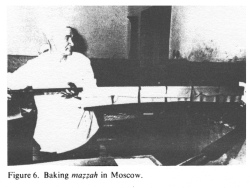
Encyclopaedia Judaica (1971): Moscow, vol. 12, col. 365.
Baking mazzah in Moscow.
The ritual slaughtering of poultry was allowed in the
precincts of the Great Synagogue whereas kosher beef was
obtainable until 1964 twice a week at a special store on the
outskirts of the city. (col. 367) [[...]]
[1970]
In 1970 three synagogues were functioning in the city of
Moscow. Apart from the Great Synagogue on Arkhipova Street,
there were two small synagogues - in the suburbs of Maryina
Roshcha and Cherkizovo, which were wooden buildings, more of
the type of a
shtibl
[[small room]] than of a full-fledged synagogue. In addition
to them, there was a synagogue in the nearby town of
Malakhovka, practically also a suburb of Greater Moscow,
which has had a sizable Jewish population from
prerevolutionary times. (col. 366)
[Contacts with racist
Zionist Free Mason CIA Herzl Israel]
Contacts with Israel took manifold forms. The Israel embassy
invited to its receptions not only the rabbis and board
members of the various synagogues, but also Jewish writers,
artists, and other intellectuals. In various sport events,
international scientific congresses, and international
exhibitions [[racist Zionist Free Mason CIA Herzl]] Israel
was almost always represented, and often not only Moscow
Jews but also Jews from other parts of the Soviet Union,
even from outlying regions, came especially to the capital
"to see the Israelis". From time to time Israel popular
singers (e.g., Nechama Hendel, Geulah Gil, etc.) and other
artists performed in Moscow and aroused great enthusiasm,
particularly among young Jews.

Encyclopaedia Judaica (1971): Moscow, vol. 12, col. 361.
The Israel Embassy in Moscow, prior to June 1967
The Six-Day War and the rupture of diplomatic relations
between the Soviet Union and [[racist Zionist Free Mason CIA
Herzl]] Israel (June 1967) put an end to these contacts.
[[The Six-Day War was a national climax for the Jewish
racist Zionist Free Mason CIA Herzl government, and racist
members of the government said the new occupations were a
step forward to a "Greater Israel", e.g. Moshe Dayan.
Palestinians were treated like pigs]].
But, on the other hand, many Moscow Jews, especially the
young, began more and more openly to demonstrate their
pro-Israel feelings - by continuing increasingly their mass
gatherings around the Great Synagogue, by signing collective
protests against the refusal to grant them exit permits to
[[racist Zionist Free Mason CIA Herzl]] Israel, by studying
Hebrew in small groups, etc. Unlike other cities, like
*Riga, *Leningrad, *Kishinev, and some towns in *Georgia,
there were hardly any sanctions applied in Moscow in 1970
against pro-Israel Jews. [[...]]
[ED.]> (col. 368)
| Sources |
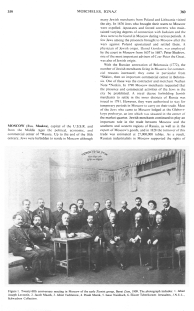
Encyclopaedia Judaica (1971): Moscow, vol. 12,
col. 359-360
|

Encyclopaedia Judaica (1971): Moscow, vol. 12,
col. 363-364
|
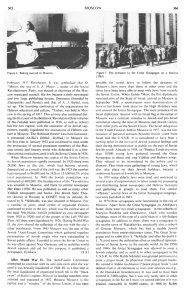
Encyclopaedia Judaica (1971): Moscow, vol. 12,
col. 365-366
|
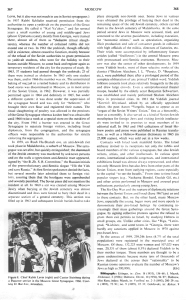
Encyclopaedia Judaica (1971): Moscow, vol. 12,
col. 367-368
|

Encyclopaedia Judaica (1971): Moscow, vol. 12,
col. 363. Israel national basketball team at the
opening in Moscow of the Eighth European
Basketball Championship games, 1953. Photo Baruch
Bagg, Tel Aviv
|
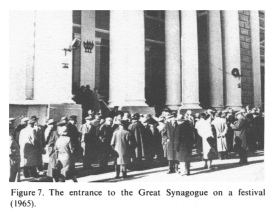
Encyclopaedia Judaica (1971): Moscow, vol. 12,
col. 366. The entrance to the Great Synagogue on a
festival (1965)
|
|
|
|
|



![Encyclopaedia Judaica (1971):
Moscow, vol. 12, col. 359-360. Twenty-fifth
anniversary meeting in Moscow of the early [[racist]]
Zionist group, Benei Zion, 1909. The photograph
includes: 1. Jehiel Joseph Levontin, 2. Jacob Mazeh,
3. Jehiel Tschlenow, 4. Pesah Marek, 5. Isaac
Naiditsch, 6. Eliezer Tcherikower. Jerusalem,
J.N.U.L., Schwadron Collection Encyclopaedia Judaica (1971): Moscow, vol. 12,
col. 359-360. Twenty-fifth anniversary meeting in
Moscow of the early [[racist]] Zionist group, Benei
Zion, 1909. The photograph includes: 1. Jehiel Joseph
Levontin, 2. Jacob Mazeh, 3. Jehiel Tschlenow, 4.
Pesah Marek, 5. Isaac Naiditsch, 6. Eliezer
Tcherikower. Jerusalem, J.N.U.L., Schwadron
Collection](EncJud_Moskau-d/EncJud_Moscow-band12-kolonne359-360-rass-zionisten1909-33pr.jpg)










